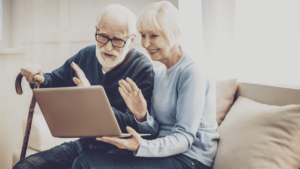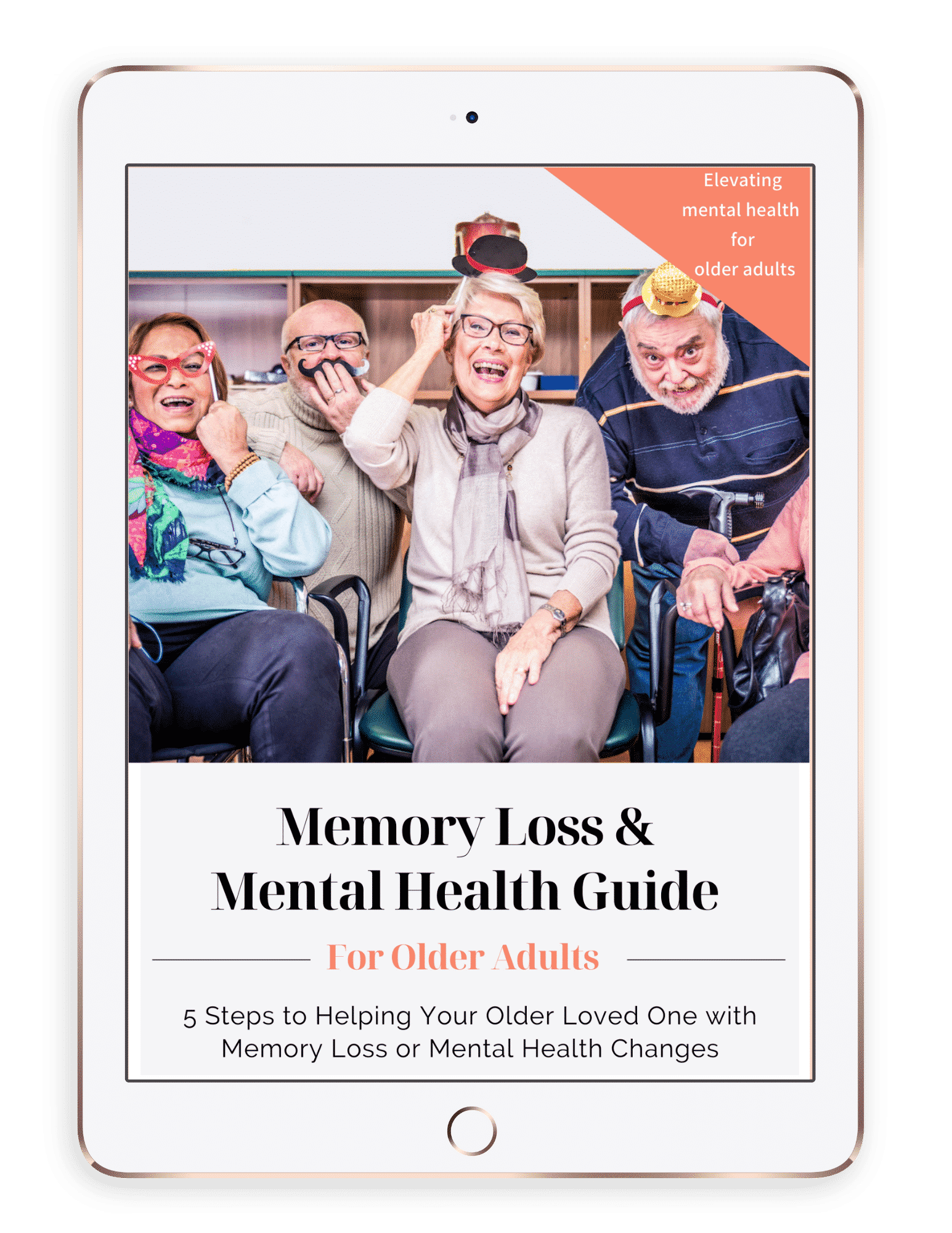If you work with older adults, you’ve probably heard this question more times than you can count: “What can I do to keep my brain healthy?”
The Global Council on Brain Health (GCBH) offers some of the most trustworthy, plain-English answers. Convened by AARP (with partners like Age UK), the GCBH brings together international experts to review the science and issue consensus recommendations for adults 50+—and for the professionals who support them. These short, visually clear guides are designed to help people understand what actually helps to protect the brain as we age.
Here’s what I appreciate most: the guides frame change as possible at any age, honoring culture, identity, and autonomy—an empowering stance that aligns with pro-aging, anti-ageist practice. They’re not about hacking your brain; they’re about building a life that supports your brain—through relationships, purpose, movement, nourishment, restorative sleep, and meaningful mental challenge.
Below, I introduce six cornerstone GCBH guides (linked for easy download) and highlight the key takeaways you can share directly with clients, families, and teams. Use them in psychoeducation, handouts, group curricula, and care-plan conversations. They’re clear, actionable, and ideal for building momentum—one small habit at a time.
1) Mental Well-Being & Brain Health
Guide: Brain Health and Mental Well-Being → https://doi.org/10.26419/pia.00037.001
Why it matters:
Mood, stress, and purpose aren’t side quests; they’re core to how the brain works day to day. Mental well-being is the foundation that supports everything else—movement, nutrition, sleep, and social engagement. When people feel better, they do the things that keep the brain healthier.
What you’ll get in this guide:
-
A clear overview of how mood, stress, and purpose impact memory, attention, and day-to-day functioning
-
Simple, evidence-based strategies (behavioral activation, stress resets, sleep hygiene, social micro-connections)
-
Practical checklists for daily habits and weekly “tiny wins”
-
Guidance on when to seek therapy, community programs, and medication reviews
How it helps:
Turns “I should feel better” into doable steps that stick—grounded in compassion, identity, and autonomy.
Key takeaways to share with clients
- Make meaning daily. Encourage enjoyable, values-aligned activities; enjoyment itself supports mental well-being.
- Connect with neighbors and community. More frequent socializing correlates with higher well-being scores among adults 50+.
- Protect sleep. Maintain a consistent schedule, keep screens out of bed, and minimize evening blue light exposure.
- Mind–body practices help. Invite yoga, tai chi, breathing, and meditation; systematically address chronic stress with exercise, mindfulness, and therapy.
- Review medications. Some meds raise risk for anxiety, depression, and insomnia—coordinate with prescribers and review regularly.
Client-friendly language:
“Let’s choose one activity that feels like you—five minutes today. Small is smart.”
2) Physical Activity & Brain Health
Guide: The Brain–Body Connection: Physical Activity and Brain Health → https://doi.org/10.26419/pia.00013.001
Why it matters:
Physical activity improves attention, processing speed, and executive functioning, while reducing risk factors that chip away at cognitive vitality (think: insulin resistance, high blood pressure, inflammation). Movement is one of the most reliable, accessible “dosages” we can prescribe.
What you’ll get:
-
A plain-English summary of how movement supports attention, processing speed, and executive function
-
Starter templates for mixing aerobic, strength, and balance activities (with adaptations for pain and fall risk)
-
“Something beats nothing” action plan with 10-minute options, habit-stacking ideas, and safety tips
-
Motivation tools for pairing movement with joy and social connection
How it helps:
Makes exercise approachable and customizable, so clients build consistency without overwhelm.
Key takeaways to share with clients:
-
Move most days. Encourage aerobic + strength + balance activities appropriate to ability and medical status; “something is better than nothing,” and more variety is protective.
-
Pair movement with purpose. Walking with a friend (social + aerobic), tai chi (balance + mindful movement), or dance class (coordination + joy) leverages multiple brain-health pathways.
-
Pain or fall concerns? Adapt—it still “counts.” Chair exercises, water aerobics, or PT-guided routines keep the door open.
Client-friendly language:
“Let’s bundle movement with a routine you already do—right after breakfast or right after your favorite show.”
3) Nutrition & Brain Health
Guide: Brain Food: Nourishing Your Brain Health → https://doi.org/10.26419/pia.00019.001
Why it matters:
What supports heart health generally supports brain health. The GCBH steers people toward food patterns (think Mediterranean/MIND), not miracle products. It’s realistic, budget-aware, and compatible with many cultures and preferences.
What you’ll get:
-
A food-first guide to brain-healthy eating patterns (Mediterranean/MIND) across cultures and budgets
-
“Add / Swap / Reduce” graphics for groceries and meals—no fads, no gimmicks
-
Smart supplementation guidance (when it’s useful, when it isn’t)
-
Sample meal and snack ideas your clients can actually stick with
How it helps:
Replaces nutrition noise with realistic, sustainable changes that support heart-and-brain health.
Key takeaways to share with clients:
-
Superfoods aren’t the hero, consistent nutrition is. Emphasize plant-forward eating (leafy greens, berries), fish/seafood, legumes, nuts, whole grains, and healthy oils; limit saturated fat, ultra-processed foods, added sugars, and excess salt.
-
Encourage screening for vitamin deficiencies.
-
Make changes that are small and sustainable. Even modest shifts (e.g., one extra daily fruit serving) can yield meaningful cardiometabolic—and thus brain-health—benefits.
-
Context matters. Tailor to culture, budget, access, preferences, and comorbidities; no single food is “the answer,” and equity-minded care counts.
Client-friendly language:
“Pick one swap this week- are you open to trying olive oil instead of butter?”
4) Social Engagement & Brain Health
Guide: The Brain and Social Connectedness → https://doi.org/10.26419/pia.00015.001
Why it matters:
Humans are built for connection. High-quality, meaningful interactions support mental well-being and are associated with better cognitive outcomes across the lifespan. What you do—and who you do it with—matters.
What you’ll get:
-
The why behind connection: how meaningful relationships protect cognition and well-being
-
A menu of options tailored to personality, culture, mobility, language, and interests
-
Ideas for reciprocal roles (volunteering, mentoring, intergenerational programs) that add purpose
-
A one-page “connection plan” template—one meaningful touch + one micro-connection each week
How it helps:
Moves beyond “be social” to specific, identity-affirming ways to belong and thrive.
Key takeaways to share with clients:
-
Prioritize meaningful connection. The benefits depend on what people do and with whom—the quality and safety of interactions matter for cognitive outcomes.
-
Avoid one-size-fits-all social engagement. Personality, culture, gender, life events (retirement, bereavement), disability, and living arrangements shape engagement—avoid one-size-fits-all prescriptions.
-
Build variety and reciprocity. Encourage roles that give and receive support—volunteering, interest-based groups, intergenerational programs—especially for folks at risk of isolation.
Client-friendly language:
“Let’s schedule one meaningful conversation and one simple micro-connection this week.”
5) Cognitively Stimulating Activities
Guide: Engage Your Brain: Cognitively Stimulating Activities → https://doi.org/10.26419/pia.00001.001
Why it matters:
Brains remain adaptable. Learning and mentally challenging activities help build cognitive reserve—the brain’s ability to cope with change. The GCBH favors rich, real-world skills over narrow “brain game” claims.
What you’ll get:
-
An encouraging primer on cognitive reserve and lifelong learning
-
Real-world activity ideas (new skills, clubs, arts, languages, making/repairing) with level-up steps
-
A balanced look at “brain games”—where they fit and their limits
-
A two-block weekly practice plan to build momentum without perfectionism
How it helps:
Channels curiosity into enjoyable, mentally rich routines that clients will keep doing.
Key takeaways to share with clients
- “Use it and enjoy it.” Learning new skills, continuing education, complex leisure, and mentally challenging work/volunteering are linked with better cognitive outcomes in later life.
- Be cautious with “brain games.” Evidence for commercial brain games is limited and often over-stated; everyday cognitively rich activities offer broader, more transferable benefits.
- Start now; any age helps. Earlier and sustained engagement is best, but it’s never too late to begin adding mental challenges that are enjoyable and meaningful.
Client-friendly language:
“What have you always wanted to try? Let’s give it two 15-minute blocks this week.”
6) Sleep: Reset Your Rhythm
Guide: The Brain–Sleep Connection → https://doi.org/10.26419/pia.00014.001
Why it matters:
Sleep is the brain’s maintenance window—consolidating memory, clearing metabolic byproducts, and supporting mood and attention. Aging can change sleep architecture, but excessive daytime sleepiness, loud snoring, or chronic insomnia are not “just getting older.” They’re signals to address.
What you’ll get:
-
A friendly breakdown of how sleep supports memory, mood, and attention—plus what changes with age
-
A “reset your rhythm” routine (consistent wake time, light, movement, wind-down)
-
Quick wins for evenings: screens, caffeine/alcohol, heavy meals, and environment tweaks
-
Red-flag checklist for when to seek medical evaluation (insomnia, snoring/apneas, RLS, daytime sleepiness)
How it helps:
Normalizes common changes while making it clear what’s treatable—and how to start sleeping better now.
Key takeaways to share with clients:
-
Get clear about age-related changes vs. sleep problems. Educate that lighter sleep and more awakenings can occur with age—but chronic sleepiness warrants assessment (consider depression, medications, Obstructive Sleep Apnea, Restless Leg Syndrome).
- Screen and refer. Persistent insomnia, snoring/apneas, parasomnias, or excessive daytime sleepiness merit medical evaluation; many sleep disorders are treatable.
-
Prescribe routine. A regular sleep–wake schedule, daytime light exposure, and physical activity support sleep and brain health.
-
Encourage sleep hygiene. Reduce late caffeine/alcohol, limit screen light before bed, and maintain a calming pre-sleep ritual—interventions that pair beautifully with Cognitive Behavioral Therapy – Insomnia.
Client-friendly language:
“Let’s choose a fixed wake-up time and add a simple wind-down tonight—same playlist, same steps.”
How to Use These Guides With Your Clients (and Teams)
-
As psychoeducation that builds agency. Each report is short, evidence-informed, and practical—ideal for normalizing concerns (“you’re not alone”), clarifying what works, and translating goals into habits. The GCBH explicitly positions its guidance as consensus-based, trustworthy information to help people make informed choices now.
-
To inform care plans across disciplines. Share the report links with primary care, neurology, PT/OT, dietitians, sleep clinics, and senior-center partners. These are common-language frameworks that improve continuity of care and reinforce consistent messaging.
-
To reduce stigma and ageism. The guides frame change as possible at any age, honoring culture, identity, and autonomy—an empowering stance that aligns with pro-aging, anti-ageist practice.
Quick Links to Download & Share With Clients
-
Sleep: The Brain–Sleep Connection → https://doi.org/10.26419/pia.00014.001
-
Social Engagement: The Brain and Social Connectedness → https://doi.org/10.26419/pia.00015.001
-
Nutrition: Brain Food: Nourishing Your Brain Health → https://doi.org/10.26419/pia.00019.001
-
Physical Activity: The Brain–Body Connection → https://doi.org/10.26419/pia.00013.001 (cross-referenced in GCBH nutrition guide)
-
Mental Well-Being: Feeling Good and Functioning Well → https://doi.org/10.26419/pia.00037.001
-
Cognitive Stimulation: Engage Your Brain → https://doi.org/10.26419/pia.00001.001
Encourage clients to read (or skim) one section at a time and bring questions to session. Many will appreciate “consensus” guidance vetted by international experts;.
Putting It All Together in Care
Here’s a simple, client-facing framework you can adapt:
- Protect your mood (Mental Well-Being): Schedule enjoyable activities, add stress-relief practices, and seek treatment when anxiety or depression are present.
- Move your body, train your brain (Physical Activity): Aim for near-daily movement that blends aerobic, strength, and balance; connect it to routines and joys.
-
Nourish your neurons (Nutrition): Shift toward a MIND-style pattern—leafy greens and berries routinely; fish weekly; olive oil for cooking; limit ultra-processed foods and excess salt.
-
Connect with purpose (Social): Build a weekly “meaningful connection” calendar—one give, one receive—so relationships feel mutual and energizing.
-
Reset your rhythm (Sleep): Choose a consistent wake time, add morning light, and build an evening wind-down. Track daytime sleepiness; if persistent, get evaluated.
-
Challenge your mind (Cognitive Stimulation): Learn something new, increase complexity gradually, and prefer rich, real-world skills over narrow “brain games”.
These interconnected domains reinforce one another: movement improves sleep; social connection lifts mood; healthy eating supports energy for activity; cognitive challenges add meaning and self-efficacy. That synergy is the heart of the GCBH’s message and mirrors what we see clinically.
Call to Action
If you support older adults—in therapy, social work, care management, long-term care, or community programming—download the GCBH guides above and share them with your clients, families, and teams. Choose one focus area this week (sleep, nutrition, or connection) and turn it into a small, doable experiment. Then build from there.
Take a CEU Course focused on Mental Health + Aging
Also, if you’d like CE courses that translate these recommendations into clinical practice, explore our CEU courses at the Center for Mental Health & Aging. And if this blog was useful, please share it with a colleague or friend—together we can spread brain-healthy practices that change lives.
Remember, it’s only with your help that we can meet the mental health needs of older adults, so thank you for being here.




